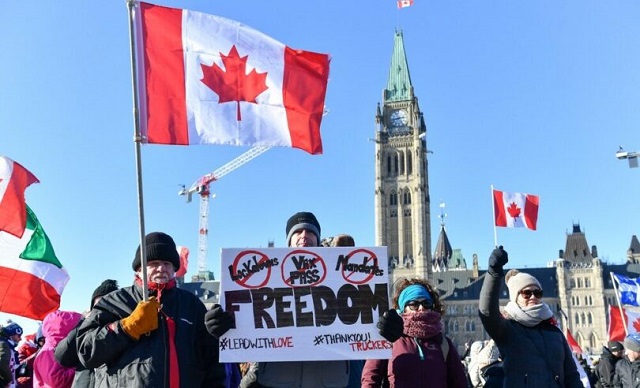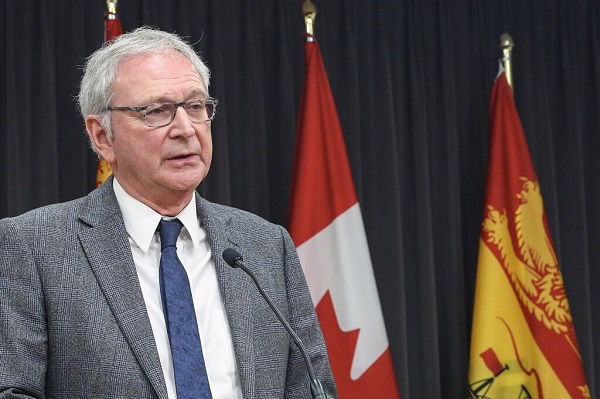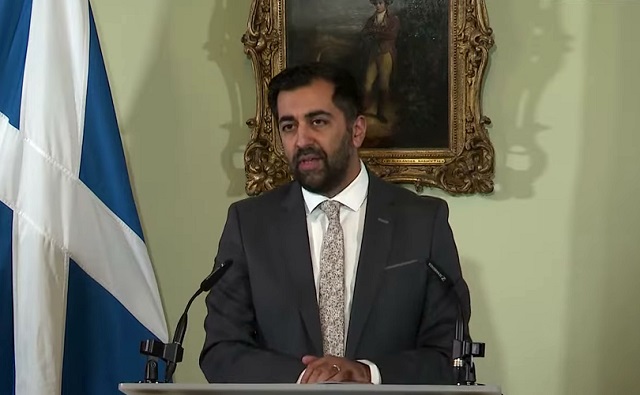Housing
Trudeau admits immigration too much for Canada to ‘absorb’ but keeps target at record high

From LifeSiteNews
Despite his admission that the influx of people has outpaced Canada’s ability to sustain itself, Trudeau said he is committed to continuing his government’s plan to bring in 500,000 permanent immigrants each year.
Prime Minister Justin Trudeau has admitted that his mass immigration policies have driven Canadians’ wages down and attributed to the housing crisis, but he still insists on bringing in hundreds of thousands of people each year.
During an April 2 media conference in Dartmouth, Nova Scotia, Trudeau acknowledged that his immigration policies have negatively affected Canadians after a journalist questioned him on how his policies have contributed to record high unaffordability in the nation.
“Over the past few years, we’ve seen a massive spike in temporary immigration, whether it’s temporary foreign workers or whether it’s international students in particular that have grown at a rate far beyond what Canada has been able to absorb,” he admitted.
PM Trudeau says immigration to Canada has "grown at a rate far beyond what Canada has been able to absorb," adding that "temporary immigration has caused so much pressure in our communities," in relation to housing #cdnpoli pic.twitter.com/3ASFufZKID
— Mackenzie Gray (@Gray_Mackenzie) April 2, 2024
“To give an example, in 2017, two per cent of Canada’s population was made up of temporary immigrants,” Trudeau continued. “Now we’re at 7.5 per cent of our population comprised of temporary immigrants. That’s something we need to get back under control.”
Amid heckling from protestors, Trudeau acknowledged that the immigration crisis must be solved. However, he attributed the negative effects only to the spike in “temporary” immigrants, who he claims are “putting pressure on our communities.”
“That’s something that we need to get back under control, both for the benefit of those people because international students we’re seeing increasingly vulnerable to mental health challenges, to not being able to thrive and get the education they want,” he stated.
“But also, increasingly more and more businesses [are] relying on temporary foreign workers in a way that is driving down wages in some sectors,” Trudeau continued.
Despite the admission, Trudeau announced that he still plans to bring in permanent immigrants at a record pace, despite Canadians struggling to afford homes and even food.
“Every year, we bring in about 450,000, now close to 500,000, permanent residents a year, and that is part of the necessary growth of Canada,” he insisted. “It benefits our citizens, our communities, it benefits our economy.”
While Trudeau remains insistent that mass immigration “benefits” the economy, recent figures show that the nation’s GDP per capita growth rate is dismal compared to other countries with lower relative immigration levels like the United States.
The Bank of Canada has even gone as far as saying that the weakening productivity of the nation’s economy has become “an emergency.”
In March, Canada reached a population of 41 million, just 9 months after hitting the 40 million mark. Such growth is unprecedented in recent history and among the highest immigration rates in the world.
Trudeau’s acknowledgment comes as a recent report found that Canada is one of the unhappiest places in the West for people in their 20s as young Canadians are experiencing the effects of Trudeau’s government, which has been criticized for its overspending, onerous climate regulations, lax immigration policies, and “woke” politics.
Additionally, a March poll revealed that seven out of 10 Canadians believe the country is broken and that the Trudeau government does not focus on issues that matter.
Furthermore, many have pointed out that considering rising home prices, many Canadians under 30 are at risk of never being able to purchase a home.
City of Red Deer
City Council paving the way for more house suites, backyard suites, tiny homes, and duplexes

Council adopts new Zoning Bylaw
At Monday’s regular City Council meeting, City Council passed second and third reading of the Zoning Bylaw 3357/2024, replacing the former Land Use Bylaw.
The goal of the Zoning Bylaw is to reduce red tape, permit more uses in each zone and improve ease and understanding of the document. Notable updates include:
- Reduction from 11 residential districts to 9 zones
- Reduction from 7 commercial districts to 6 zones
- Reduction from 5 industrial districts to 3 zones
- More permitted uses in each zone
- More gentle density options to provide increased housing options, including house suites, backyard suites, tiny homes, and duplexes
- Increased building heights to 12.5m that considers sightlines and privacy of existing dwellings
- Greater flexibility for development applications
- Expanded definitions
- Reduction of duplex side yards, removal of side yard setbacks on corner lots, and reduced frontage in residential narrow lots to improve competitiveness
- New regulations to gently transition existing neighbourhoods to maintain character
Following adoption of the Zoning Bylaw, the following amendments were made by City Council.
| Proposed Amendment | Public Hearing Date |
| Increase suites from 15% to 25% of the houses in a neighbourhood. | June 24, 2024 |
| Allow commercial uses on the main floor of R-H Residential High Density. | June 24, 2024 |
| Correct errors in the PS Public Service Zone use list: (*Recommended) a) Gaming and Gambling Establishment (Only at the Westerner) b) Education Primary & Secondary – Add to discretionary use list | May 27, 2024 |
| Returning the Cannabis Retail Sales setbacks to be consistent with the current Land Use Bylaw 3357/2006 | May 27, 2024 |
“The new Zoning Bylaw incorporates years of public feedback and best practices to make a Zoning Bylaw that will result in more housing options, easier development, and ultimately will improve our competitiveness,” said David Girardin, Major Projects Planner. “With the approval of the Zoning Bylaw today, we are not finished our community engagement as there will be future public hearings on potential amendments in the coming weeks, as well as more formal public participation for each additional phase of the Zoning Bylaw.”
The Zoning Bylaw will come into effect in 30 days. Public participation for phase two of the Zoning Bylaw will begin later this year. For more information, visit engage.reddeer.ca.
Economy
Ottawa’s homebuilding plans might discourage much-needed business investment

From the Fraser Institute
In the minds of most Canadians, there’s little connection between housing affordability and productivity growth, a somewhat wonky term used mainly by economists. But in fact, the connection is very real.
To improve affordability, the Trudeau government recently announced various financing programs to encourage more investment in residential housing including $6 billion for the Canada Housing Infrastructure Fund and $15 billion for an apartment construction loan program.
Meanwhile, Carolyn Rogers, senior deputy governor of the Bank of Canada, recently said weak business investment is contributing to Canada’s weak growth in productivity (essentially the value of economic output per hour of work). Therefore, business investment to promote productivity growth and income growth for workers is also an economic priority.
But here’s the problem. There’s only so much financial capital at reasonable interest rates to go around.
Because Canada is a small open economy, it might seem that Canadian investors have unlimited access to offshore financial capital, but this is not true. Foreign lenders and investors incur foreign exchange risk when investing in Canadian-dollar denominated assets, and the risk that Canadian asset values will decline in real value. Suppliers of financial capital expect to receive higher yields on their investments for taking on more risk. Hence, investment in residential housing (which the Trudeau government wants to promote) and investment in business assets (which the Bank of Canada warns is weak) compete against each other for scarce financial capital supplied by both domestic and foreign savers.
For perspective, investment in residential housing as a share of total investment increased from 22.4 per cent in 2000 to 41.3 per cent in 2021. Over the same period, investment in two asset categories critical to improving productivity—information and communications equipment and intellectual property products including computer software—decreased from 30.3 per cent of total domestic investment in 2000 to 22.7 per cent in 2021.
What are the potential solutions?
Of course, more financial capital might be available at existing interest rates for domestic investment in residential housing and productivity-enhancing business assets if investment growth declines in other asset categories such as transportation, roads and hospitals. But these assets also contribute to improved productivity and living standards.
Regulatory and legal pressures on Canadian pension funds to invest more in Canada and less abroad would also free up domestic savings for increased investments in residential housing, machinery and equipment and intellectual property products. But this amounts to an implicit tax on Canadians with domestic pension fund holdings to subsidize other investors.
Alternatively, to increase domestic savings, governments in Canada could increase consumption taxes (e.g. sales taxes) while reducing or even eliminating capital gains taxes, which reduce the after-tax expected returns to investing in businesses, particularly riskier new and emerging domestic companies. (Although according to the recent federal budget, the Trudeau government plans to increase capital gains taxes.)
Or governments could reduce the regulatory burden on private-sector businesses, especially small and medium-sized enterprises, so financial capital and other inputs used to comply with often duplicative or excessive regulation can be used to invest in productivity-enhancing assets. And governments could eliminate restrictions on foreign investment in large parts of the Canadian economy including telecommunications, banking and transportation. By increasing competition, governments can improve productivity.
Eliminating such restrictions would also arguably increase the supply of foreign financial capital flowing into Canada to the extent that large foreign investors would prefer to manage their Canadian assets rather than take portfolio investment positions in Canadian-owned companies.
Canadians would undoubtedly benefit from increases in housing construction (and subsequently, increased affordability) and improved productivity from increased business investment. However, government subsidies to home builders, including the billions recently announced by the Trudeau government, simply move available domestic savings from one set of investments to another. The policy goal should be to increase the availability of risk-taking financial capital so the costs of capital decrease for Canadian investors.
Author:
-

 Health2 days ago
Health2 days agoPrivate Footage Reveals Leading Medical Org’s Efforts To ‘Normalize’ Gender Ideology
-

 COVID-192 days ago
COVID-192 days agoTrudeau government only sought legal advice after Emergencies Act was invoked, records indicate
-

 Alberta2 days ago
Alberta2 days agoProvince announces next step to revamped health care system
-

 COVID-192 days ago
COVID-192 days agoTrudeau’s public health agency recommends another experimental COVID booster
-

 Addictions2 days ago
Addictions2 days agoPoilievre attacks decriminalization of hard drugs with Safe Hospitals Act
-

 Uncategorized2 days ago
Uncategorized2 days agoRCMP recruitment failure has Alberta advocacy group calling for Provincial Police Service
-

 Alberta1 day ago
Alberta1 day agoPharmacist-led clinics improve access to health care: Lessons from Alberta
-

 Alberta2 days ago
Alberta2 days agoRed Deer Hospital Lottery – Second Chance Early Bird Prize!!!








